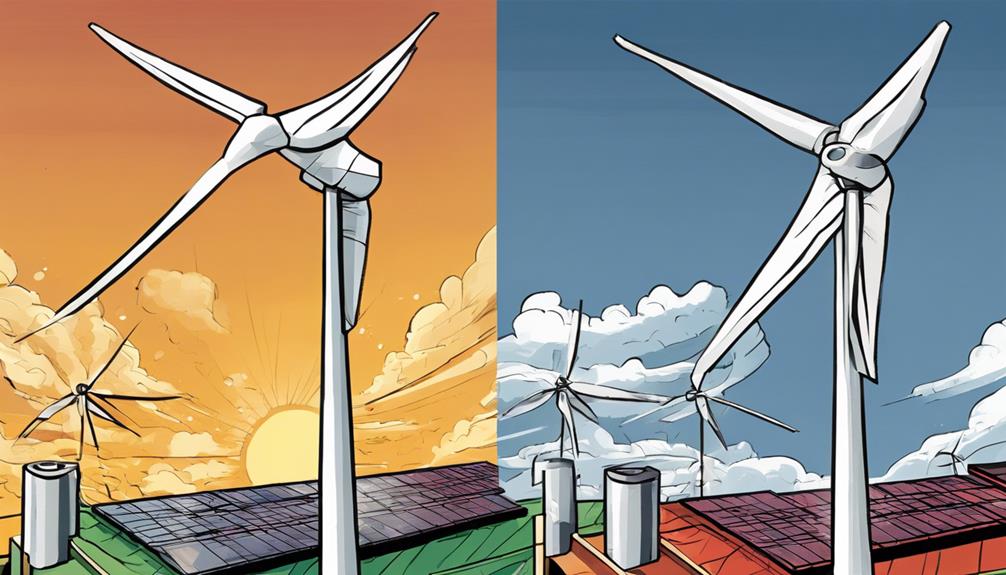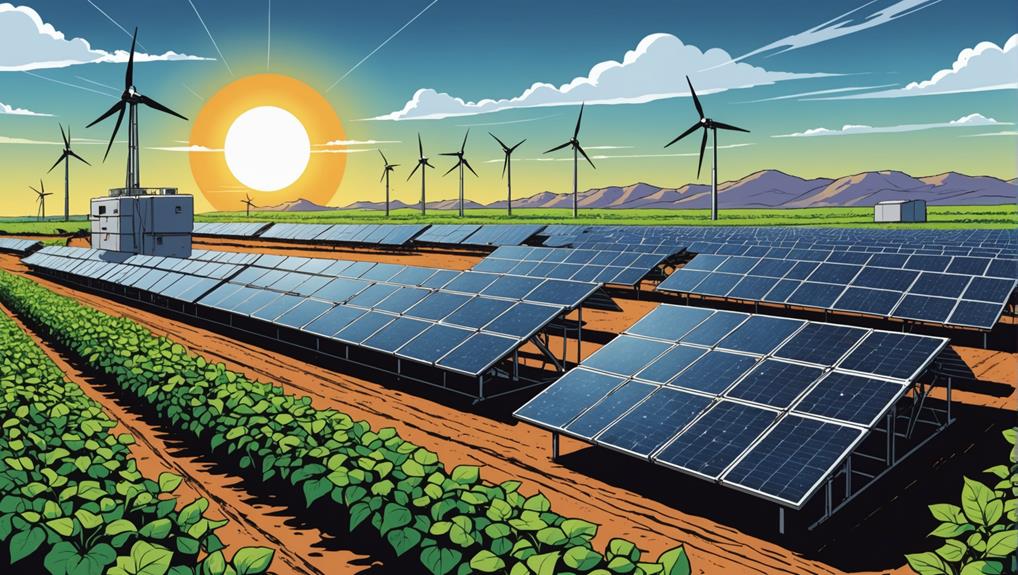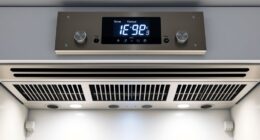Solar panels and wind turbines, two premier renewable energy sources, exhibit distinct efficiency profiles. Solar panels boast a 15-20% effectiveness rate, while wind turbines range from 30-45%. Understanding these rates is crucial for maximizing energy production and minimizing environmental impact. Factors like sunlight intensity, panel orientation, and wind speed influence effectiveness. While solar panels generate more electricity from the same sunlight, wind turbines have a higher capacity factor. As the world shifts towards renewable energy, comprehending the strengths and weaknesses of each technology is vital. By exploring further, you'll uncover the secrets to harnessing their full potential.
Key Takeaways
- Solar panels have an effectiveness rate of 15-20%, while wind turbines range from 30-45% effectiveness, influenced by various factors.
- Solar panels generate more electricity from the same sunlight amount compared to wind turbines, making them more efficient in certain conditions.
- Wind turbines have a higher capacity factor (30-40%) compared to solar panels (15-25%), but require more complex infrastructure.
- Solar panels are more cost-effective with lower initial and maintenance costs, while wind turbines have advantages in capacity and output.
- Hybrid systems combining solar panels and wind turbines can increase energy production and efficiency by leveraging the strengths of each technology.
Efficiency and Energy Production
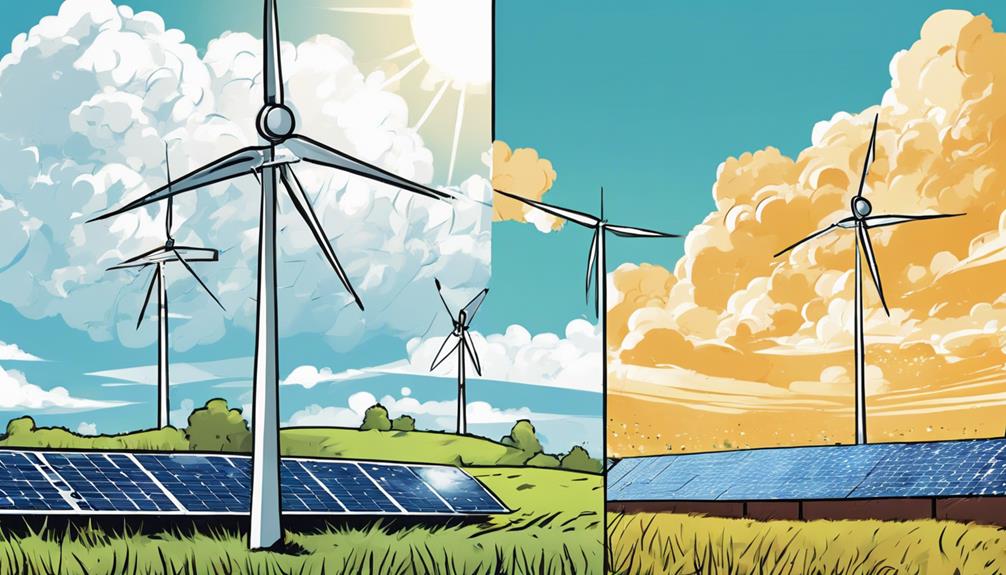
When it comes to harnessing renewable energy, solar panels and wind turbines have distinct effectiveness rates, with solar panels boasting an effectiveness of 15-20% and wind turbines ranging from 30-45%.
These effectiveness rates are influenced by various factors, including sunlight intensity and panel orientation for solar panels, and wind speed, turbine height, and geographical location for wind turbines.
Importantly, solar panels produce less energy but can generate more electricity from the same amount of sunlight compared to wind turbines. This difference is pivotal in determining the best energy production strategy.
Understanding these effectiveness rates is essential in maximizing the potential of renewable energy sources and minimizing their environmental impact.
Capacity and Output Compared

Solar panels typically range from 100 to 400 watts in output, while wind turbines can produce a significant 1 to 5 megawatts of power, underscoring the substantial difference in their capacity to generate electricity.
This disparity is also reflected in their capacity factors, with wind turbines boasting a 30-40% capacity factor, compared to 15-25% for solar panels.
Surprisingly, despite their lower output, solar panels require more space to generate the same amount of electricity as wind turbines. This is because wind turbines can harness energy from a larger area, making them a more space-efficient option.
Cost and Environmental Impact
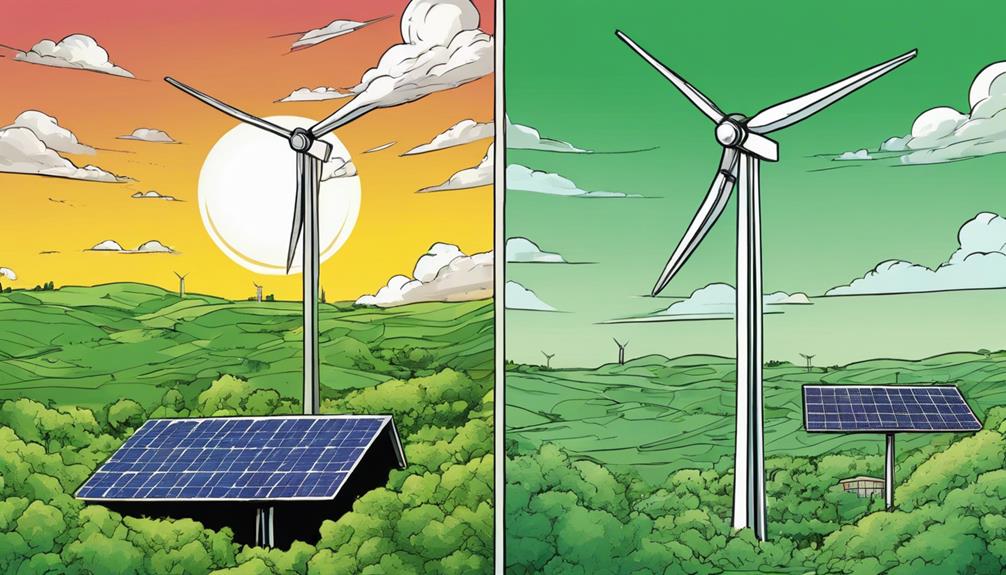
While wind turbines have a clear advantage in capacity and output, solar panels take the lead when it comes to cost and environmental impact.
Solar panels are more affordable, with lower initial and maintenance costs compared to wind turbines. They also have a longer lifespan, reducing the need for frequent replacements.
Regarding environmental impact, both sources have their pros and cons. Solar panels require more land area for installation, but wind turbines need raw materials for production. Additionally, wind turbines require complex infrastructure for electricity transmission.
Geographical Factors and Skills
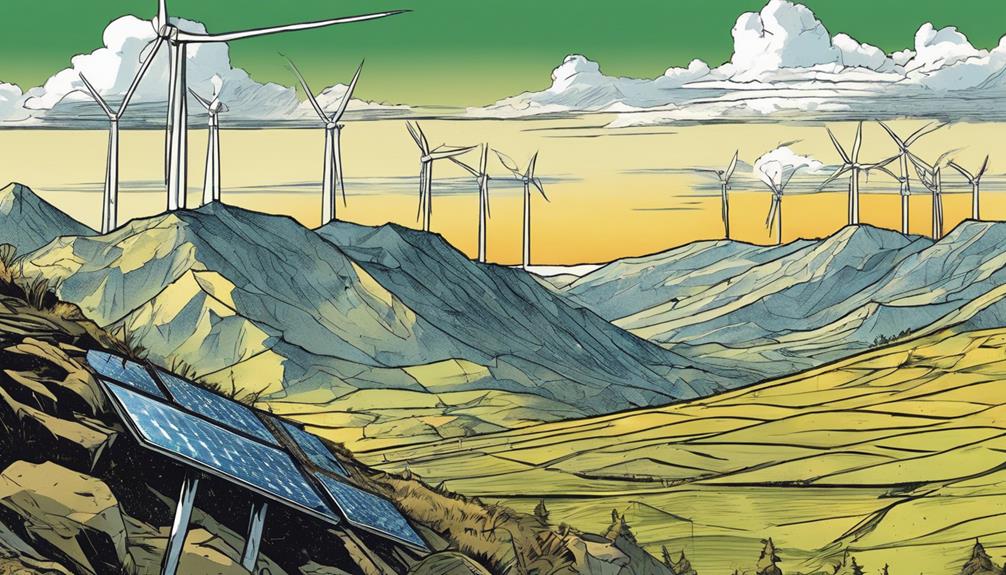
Latitude, longitude, topography, and proximity to water bodies greatly influence the availability of sunlight and wind, making certain regions more suitable for either solar panels or wind turbines. For instance, areas near the equator receive more direct sunlight, making them ideal for solar panels. Conversely, windy regions like coastlines or mountainous areas are better suited for wind turbines.
The climate also plays a significant role, with sunny regions ideal for solar panels and windy regions ideal for wind turbines.
The installation and maintenance of these systems require specific skills. Solar panel installation demands electrical wiring skills, while wind turbine installation needs construction skills. Proper training ensures safe installation and maintenance, which is essential for optimal energy production.
Hybrid Systems Advantages
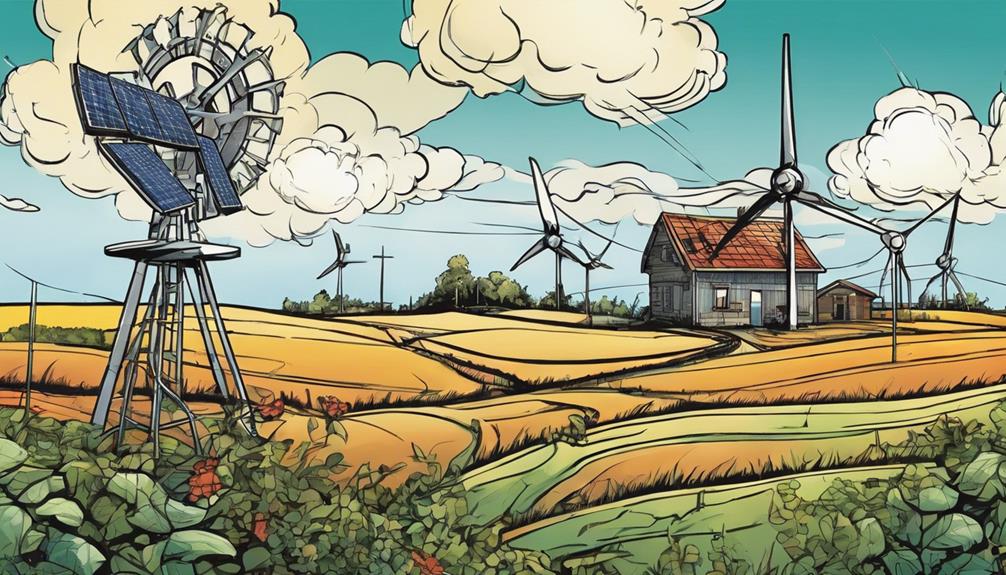
By combining solar panels and wind turbines, hybrid systems can increase energy production and maximize efficiency, providing a reliable and stable source of renewable energy.
During daylight hours, solar panels generate electricity, while wind turbines take over at night or on cloudy days. This synergy ensures a consistent energy output, mitigating the intermittency of individual sources.
Hybrid systems also optimize land use, as wind turbines can be installed on existing solar panel infrastructure. They can also leverage the strengths of each technology, such as the high capacity factor of wind turbines and the low maintenance costs of solar panels.
Frequently Asked Questions
Can Solar Panels and Wind Turbines Be Used in Residential Areas?
They can install solar panels in residential areas, but wind turbines are often not feasible due to space and noise constraints. However, hybrid systems can still be used to maximize energy production efficiently.
How Do Weather Conditions Like Storms Affect Solar and Wind Energy Production?
Notably, a single wind turbine can power over 1,400 homes annually. Storms have a big impact on energy production, with strong winds boosting wind turbine output, while heavy rain and cloud cover reduce solar panel efficiency.
Are There Any Government Incentives for Using Solar Panels and Wind Turbines?
Governments offer incentives for renewable energy adoption, including tax credits, grants, and rebates for individuals and businesses installing solar panels and wind turbines, encouraging a shift towards sustainable energy sources.
Can Solar Panels and Wind Turbines Be Used in Conjunction With Fossil Fuels?
Surprisingly, a single wind turbine can power over 1,400 homes. Yes, solar panels and wind turbines can be used in conjunction with fossil fuels to reduce emissions and increase energy diversity, promoting a hybrid approach to energy production.
Are There Any Recycling Options Available for Old Solar Panels and Wind Turbines?
Yes, recycling options exist for old solar panels and wind turbines. Manufacturers and startups are developing sustainable recycling methods to recover valuable materials like silicon, copper, and rare earth metals.
Which Is More Cost-Effective and Efficient – Solar Panels or Wind Turbines?
When comparing renewable energy costs and impacts, both solar panels and wind turbines have their advantages. Solar panels are more cost-effective for individual homeowners, while wind turbines are more efficient for large-scale energy production. Each option has its own unique benefits, making them both valuable contributors to renewable energy efforts.
How Can Solar and Wind Power Efficiency Be Compared?
When it comes to renewable energy, it’s essential to maximize solar wind power efficiency. Solar power is reliant on sunlight, while wind power depends on consistent wind speeds. Comparing their efficiency involves looking at factors like location, weather patterns, and the technology used to convert these natural resources into usable energy.
How Can Solar and Wind Power Efficiency Be Compared in the Clash of Efficiency?
When it comes to comparing the efficiency of solar and wind power, it’s important to focus on ways to maximize solar wind power efficiency. Both sources have their own strengths and weaknesses, and it’s crucial to consider factors such as location, cost, and environmental impact when looking at how they can be most effectively utilized.
Conclusion
As the renewable energy landscape continues to evolve, the battle for supremacy between solar panels and wind turbines reaches a fever pitch.
With efficiency rates, capacity, cost, and environmental impact all in the mix, the choice between these two titans of sustainable energy production is far from clear-cut.
In the end, it's a photo finish – but one thing's certain: the future of our planet depends on harnessing the incredible power of one, or both, of these energy giants.
